How to use FlashAir IoT Hub API
Latest update: September 2017
Overview
In this tutorial I will introduce the FlashAir IoT Hub API and explain the procedure for using it.
FlashAir IoT Hub provides an API that can be used to develop programs accessing FlashAir such as Web services
and applications.
By using FlashAir IoT Hub API, let's all develop web services and applications that make use of FlashAir.
In this tutorial we will explain the preparation for using the API, but since the next time we will
introduce the
application programming using the API with concrete examples, so please refer to it when developing the
application.
About API
FlashAir IoT Hub API is RESTful and easy to understand design. The API specification is published in FlashAir IoT Hub API document . API Please use FlashAir IoT Hub Terms of Use acceptance.
About authentication
The FlashAir IoT Hub API has the following authentication methods.
-
Device authentication
Basic authentication using the access token acquired in FlashAir registration.
It is mainly used to register data from FlashAir to FlashAir IoT Hub, such as the value of GPIO of FlashAir. -
Client authentication
It authenticates whether it is an application registered by the developer. The access token issued after authentication is required for user token authentication to be described later.
For application authentication, we use information (developer ID, etc.) when the developer registered the application beforehand, so developers need to embed those information in the application. -
User token authentication
It is authentication according to OAuth 2.0. It is mainly used in applications that refer to FlashAir data registered in FlashAir IoT Hub API.
Along with the above-mentioned client authentication, the user needs to authorize access when using the application.
In this tutorial, the access token issued when this access is authorized is referred to as a user token.
In addition, the authentication method used for each API is decided. For example, using user token authentication for an API for which device authentication is specified will result in an error. However, some APIs can use multiple authentication methods.
Please see the FlashAir IoT Hub API document for how to authenticate each API.
In this tutorial, I will not touch the detailed specification of OAuth 2.0. Please refer to the following.
- OAuth Community
- OAuth.com
- OAuth (Wikipedia)
- RFC6749 (OAuth 2.0)
- RFC6750 (The OAuth 2.0 Bearer Token Usage)
- RFC7636 (OAuth PKCE)
Flow of use
Let's use the FlashAir IoT Hub API. Follow the procedure below.

| Application user | Application developers | |
|---|---|---|
| 1. | Account registration | Account registration |
| 2. | - | Application registration |
| 3. | Access authorization | Access authorization |
| 4. | - | Token issuance |
I will explain the procedure of each of the application user and the application developer.
Procedure of application user
This is the procedure of using the application using FlashAir IoT Hub API.
Account registration
Please register your FlashAir IoT Hub account according to Register / Login.
Access authorization
The application displays the login screen of FlashAir IoT Hub. Please login with yourself (application user) account.
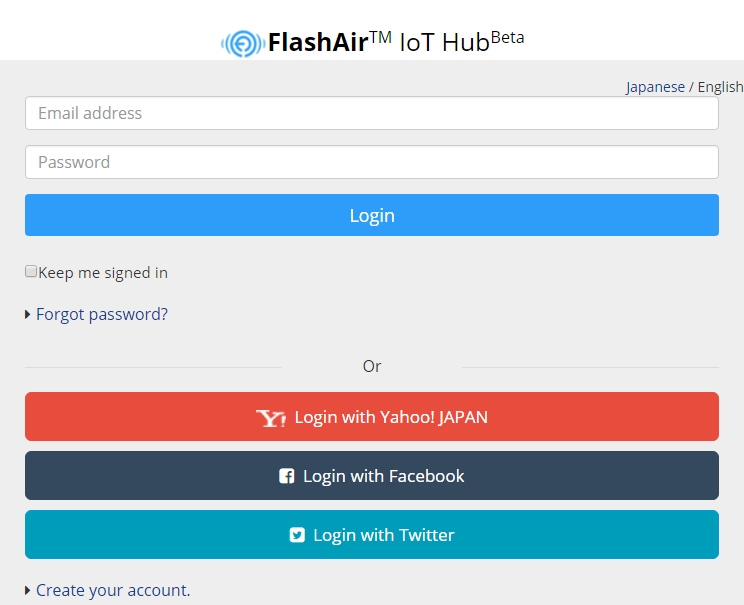
We will confirm that the application can access the data of FlashAir IoT Hub, so if you agree, please click the approval button.
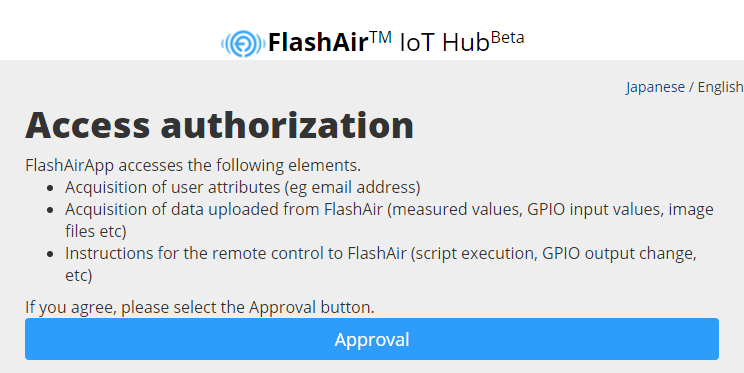
With this, applications using FlashAir IoT Hub will be available.
Procedure of the application developer
This is the procedure for using the FlashAir IoT Hub API in the application.
Account registration
Please register your FlashAir IoT Hub account according to Register / Login.
Application registration
Access authorization according to OAuth 2.0 (RFC 6749) and OAuth PKCE (RFC 7636) is necessary for use of
FlashAir IoT
Hub API.
Since access is authorized based on the information of the application, please input necessary
information and register
the application.
Please login to FlashAir IoT Hub and click the Developer's Site link on the screen.
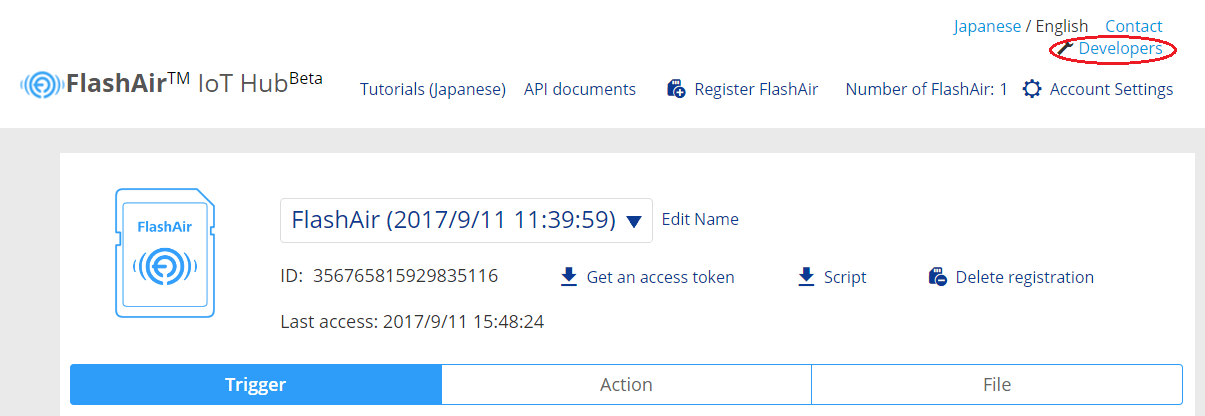
Please click the Add app link on the developer site screen.
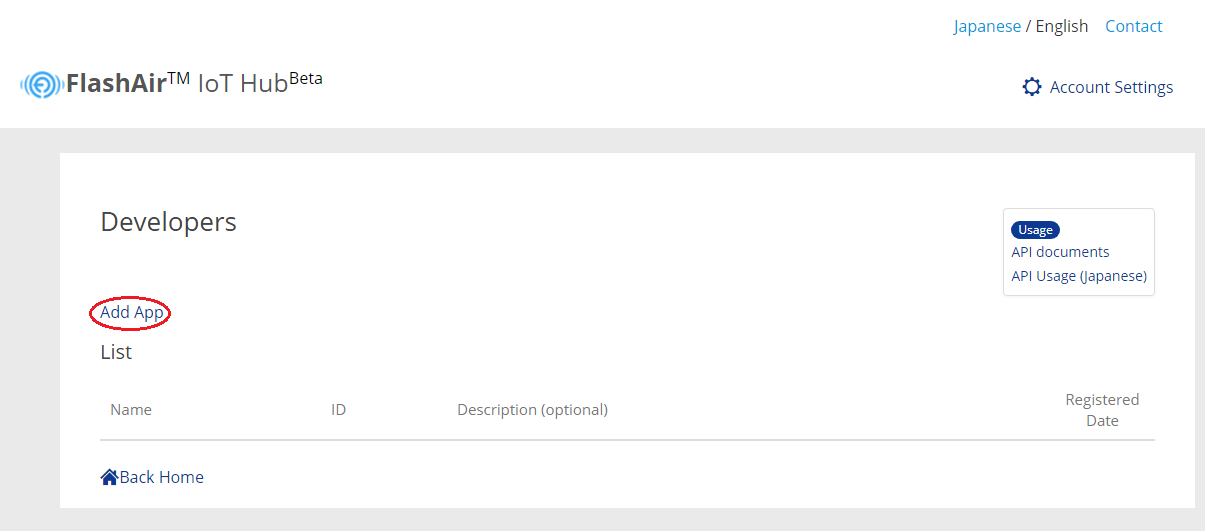
Enter necessary information and click the add button, the application will be registered.
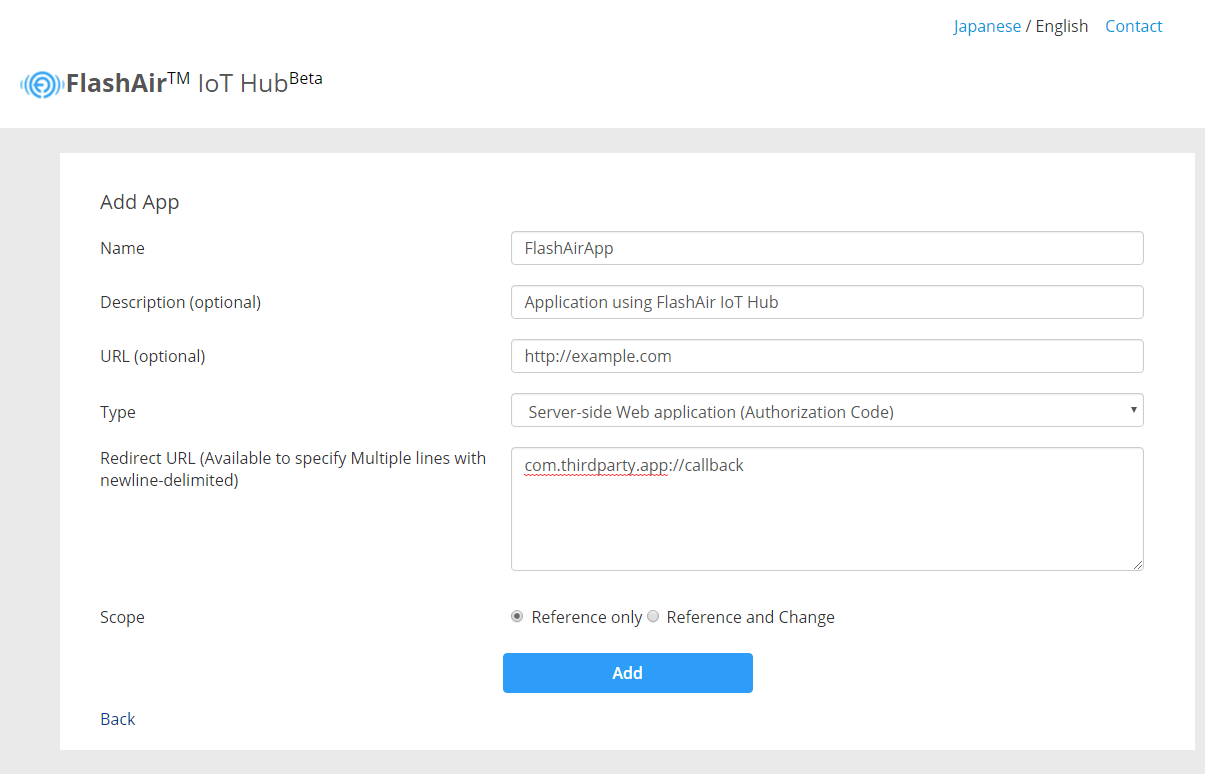
| Item | Necessity | Description |
|---|---|---|
| Name | Required | Name of the application. |
| Description | Optional | Overview of the application. |
| URL | Optional | URL of the application provision site or web service. |
| Type | Required |
Approval method according to usage form of client.
|
| Scope | Required |
Access authority of FlashAir IoT Hub API.
|
| Redirect URL | Required | The URL to redirect after authorizing access on the authorization screen.
When redirecting, specify the authorization code to the parameters of the URL, so please specify the URL accessible by the web service or application. |
After registration, the ID of the application will be displayed. The ID is used for requesting authorization. Let's implement it so that it can refer to this ID by Web service or application.
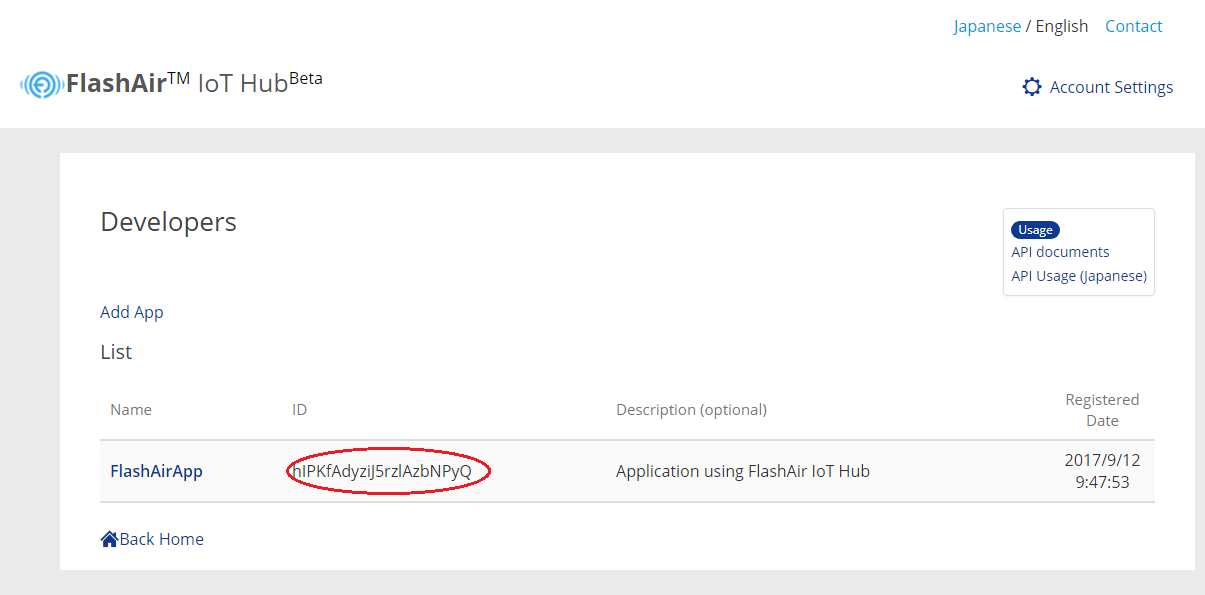
Access authorization
We will authorize you to access FlashAir IoT Hub.
Let's implement the application to display approval screen of FlashAir IoT Hub and obtain approval from
application
user.
Access authorization is done by accessing the FlashAir IoT Hub API. At that time, some parameters and
procedures
differ depending on the type of application you registered.
First, let's explain the basic access authorization procedure, so let's grasp the overall flow.
Next, I will explain details by type, so please see it according to the application you want to develop.
- Access authorization flow
- For server side web application
- For mobile / desktop application
- For client side web application
Access authorization flow
Access authorization is done in the following procedure.
-
Authorization request
Please inform the application user that access to FlashAir IoT Hub is necessary and access the authorization request API. When accessing the authorization request API, the login screen of FlashAir IoT Hub is displayed.
In order to access the authorization request API, client authentication is required. -
Acquiring access authorization and authorization code
When the application user logs in and approves the access, it passes the value of the authorization code to the application.
This authorization code serves as a voucher for token issuance.
Did you grasp the flow of access authorization? Next, I will explain the procedure by type of application.
For server side web application
Authorization request
Let's access the URL of authorization request for server side web application with the following parameters from the application from the browser.
| Parameters | Necessity | Description |
|---|---|---|
| response_type | Required | Response type.
code fixed. |
| client_id | Required | Client ID. Please specify the ID of the application displayed on the developer's site screen or application details screen. |
| redirect_uri | Optional | Client's redirect URL. Please specify the URL of the page to be displayed after authorization on the authorization request screen. If omitted, the value specified in the redirect URL is used when registering the application. |
| state | Required |
A random number character string for CSRF countermeasure specified by the client. Give the same value to
the parameter
Reference: |
| scope | Optional |
Scope string for access authorization. Please specify one of the following values. More than one can be specified with a space delimiter. If omitted, the value specified by the scope at application registration will be used.
|
Acquiring access authorization and authorization code
When you access
authorization
request for server side web application
, the login screen of FlashAir IoT Hub is displayed.
When the application user logs in and approves the access on the authorization request screen, it
redirects by assigning
the following parameter to
redirect_uri, so please obtain it with the application that developed the parameter .
-
code
Authorization code. It is used for token issuance. -
state
A random number character string for CSRF countermeasure specified by the client. Please verify that it is the same value asstatespecified at the time of request.
For example, if
redirect_uri is https://example.com/callback, it will be redirected to the following URL.
https://example.com/callback?code=xxxxxxxxxxxxxxxxxxxxxx&state=xyz
For mobile / desktop application
Authorization request
Please access the URL of authorization request for mobile desktop application with the following parameters from the application.
| Parameters | Necessity | Description |
|---|---|---|
| response_type | Required | Response type.
code fixed. |
| client_id | Required | Client ID. Please specify the ID of the application displayed on the developer's site screen or application details screen. |
| redirect_uri | Optional | Client's redirect URL. Please specify the URL of the page to be displayed after authorization on the authorization request screen. If omitted, the value specified in the redirect URL is used when registering the application. |
| state | Required |
A random number character string for CSRF countermeasure specified by the client. Give the same value to
the parameter
Reference: |
| scope | Optional |
Scope string for access authorization. Please specify one of the following values. More than one can be specified with a space delimiter. If omitted, the value specified by the scope at application registration will be used.
|
| code_challenge_method | Required | How to generate a challenge code. Corresponds only to
S256. |
| code_challenge | Required |
Challenge code. Based on the OAuth PKCE of RFC 7636, generate it from the value of
BASE64URL-ENCODE(SHA256(ASCII(code_verifier))) == code_challenge Reference: |
Acquiring access authorization and authorization code
The operation after accessing authorization Request for Mobile Desktop Application and the method of getting the authorization code are the same as authorization Request for Server Side Web Application .
For client side web application
Authorization request
Please access the URL of authorization request for client side web application with the following parameters from the application.
| Parameters | Necessity | Description |
|---|---|---|
| response_type | Required | Response type.
token fixed. |
| client_id | Required | Client ID. Please specify the ID of the application displayed on the developer's site screen or application details screen. |
| redirect_uri | Optional | Client's redirect URL. Please specify the URL of the page to be displayed after authorization on the authorization request screen. If omitted, the value specified in the redirect URL is used when registering the application. |
| state | Required |
A random number character string for CSRF countermeasure specified by the client. Give the same value to
the parameter
Reference: |
| scope | Optional |
Scope string for access authorization. Please specify one of the following values. More than one can be specified with a space delimiter.
|
Accept access authorization and user token
After accessing authorization request for client side web application , it is the same as requesting for the server-side web application authorization to display the login screen, but please be aware that the user token will be returned directly after the access approval.
When you click the approval button, redirect it by adding the following parameter to
redirect_uri. Please obtain the parameter with the application that developed it.
-
access_token
User token. When requesting the FlashAir IoT Hub API that performs user token authentication, add the following to the HTTP header.Authorization: Bearer <access_token> -
token_type
Token type. FlashAir IoT Hub API supports onlyBearer. -
expires_in
User token expiration date (unit: second). After expiration of the expiration date, the user token will be invalid.
In that case please obtain a new user token. -
state
A random number character string for CSRF countermeasure specified by the client. Please verify that it is the same value asstatespecified at the time of request. -
scope
Scope string for access authorization. We will return the value specified at the time of the request.
For example, if
redirect_uri is https://example.com/callback, it will be redirected to the following URL.
Please note that the parameter is # rather than ?.
https://example.com/callback#access_token=xxxxxxxxxxxxxxxxxxxx&state=xyz&token_type=bearer&expires_in=86400&scope=user%2eread%20flashair%2eread%20flashair%2ewrite
Token issuance
If you get the authorization code by
access authorization, let's issue the user token with
token
issue
of FlashAir IoT Hub API.
In order to access to the API of
token
issue
will require a
client
authentication
.
In the case of client side web application, this task is unnecessary because it issues user token by access authorization.
Token issue has new issue and update done after expiration date.
By updating, you can acquire a new user token without making the application user authorize access to the
application
each time, so it will be necessary for the convenience of the user.
The user token issuance is different in case of new issue and update, and some parameters are different depending on the type of application.
How to issue a token
- New issue
- Issuing token of server side web application (new issue)
- Issuing tokens for mobile / desktop applications (new issue)
- Update
-
Issuing a token (update)
* The parameters at update are the same for each application type.
Also, regardless of how token is issued token acquisition method is all the same.
Issuing token of server side web application (new issue)
| Parameters | Necessity | Description |
|---|---|---|
| grant_type | Required |
Grant type.
|
| code | Required | Authorization code. Please specify the authorization code obtained by access authorization. |
| client_id | Required | Client ID. Please specify the ID value displayed on the application list screen or details screen. |
| redirect_uri | ※ | Client's redirect URL. ※ Required if
redirect_uri is specified in
access authorization.
Otherwise you can omit it. If omitted, the value specified in the redirect URL is used when registering the application. |
Issuing tokens for mobile / desktop applications (new issue)
| Parameters | Necessity | Description |
|---|---|---|
| grant_type | Required |
Grant type.
|
| code | Required | Authorization code. Please specify the authorization code obtained by access authorization. |
| client_id | Required | Client ID. Please specify the ID value displayed on the application details screen. |
| redirect_uri | ※ | Client's redirect URL. ※ Required if
redirect_uri is specified in
access authorization.
Otherwise you can omit it. If omitted, the value specified in the redirect URL is used when registering the application. |
| code_verifier | Required | Verification code. Value used for challenge code generation. |
Issuing a token (update)
| Parameters | Necessity | Description |
|---|---|---|
| grant_type | Required |
Grant type.
|
| refresh_token | Required | Update token. Specify the value of
refresh_token obtained at the time of previous user token acquisition. |
| scope | Optional |
Scope string for access authorization. Please specify one of the following values. More than one can be specified with a space delimiter. If omitted, the value specified by the scope at application registration will be used.
|
How to get a token
When issuing a token with FlashAir IoT Hub API, the value of JSON format is returned. The sample values are shown below.
{
"access_token": "2YotnFZFEjr1zCsicMWpAA",
"token_type": "Bearer",
"expires_in": 86400,
"refresh_token": "tGzv3JOkF0XG5Qx2TlKWIA"
}-
access_token
User token. When requesting the FlashAir IoT Hub API that performs user token authentication, add the following to the HTTP header.Authorization: Bearer <access_token> -
token_type
Token type. FlashAir IoT Hub API supports onlyBearer. -
expires_in
User token expiration date (unit: second). After expiration of the expiration date, the user token will be invalid.
In that case please update the token and get a new user token. -
refresh_token
Update token. It is used when updating the user token with the same authorization method.
Issuance development token
Normally, the user token must be issued according to OAuth 2.0 in the above procedure, but if the developer wants to use it immediately without issuing a user token to a third party, such as when developing applications, from the screen of FlashAir IoT Hub you can issue user token without authorization.
To publish the development token, after registering the application, open the application details screen from the list and click the Get link of the access token.
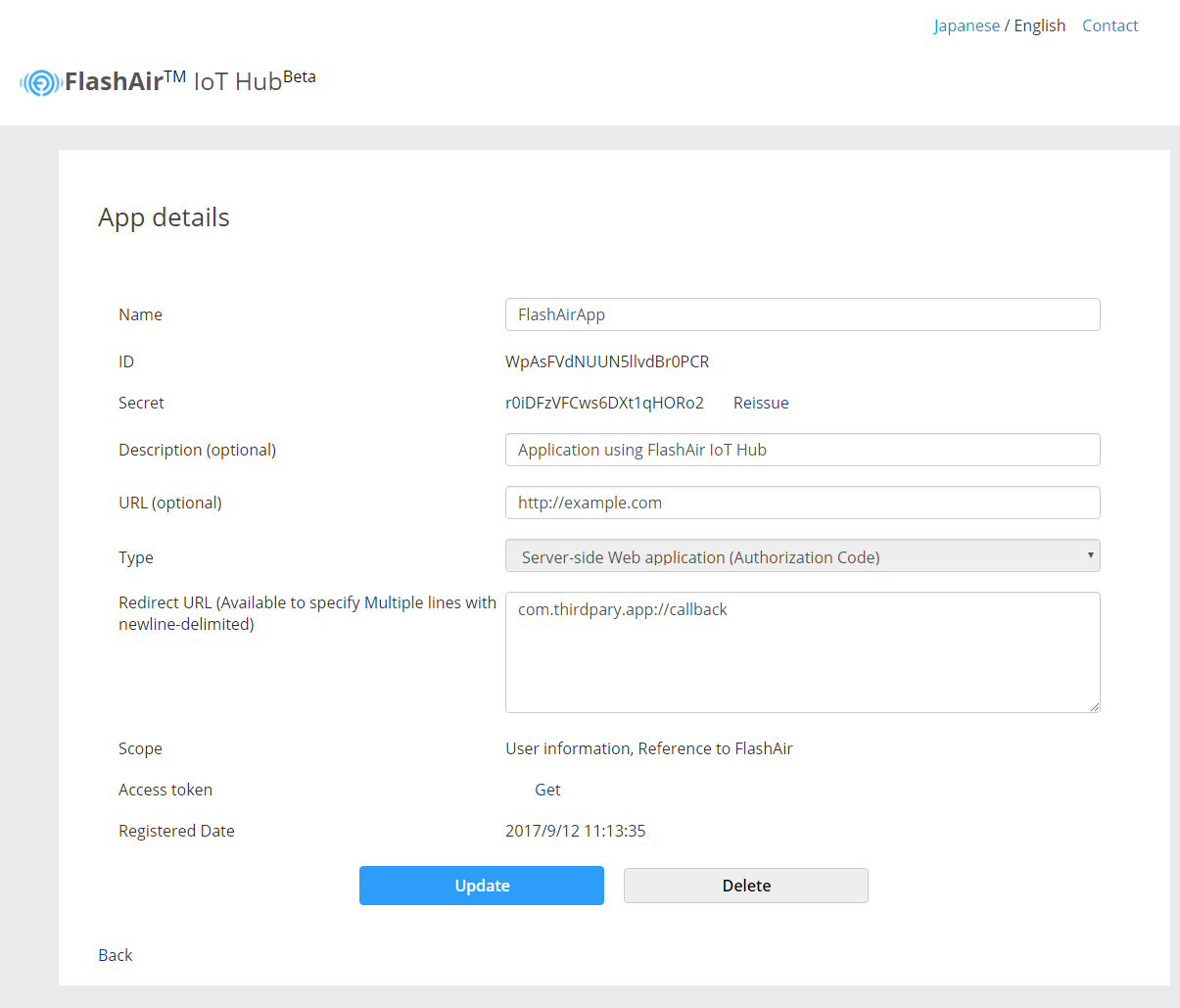
Since the user token is displayed on the screen, please use that value. Please note that there is an expiration date.
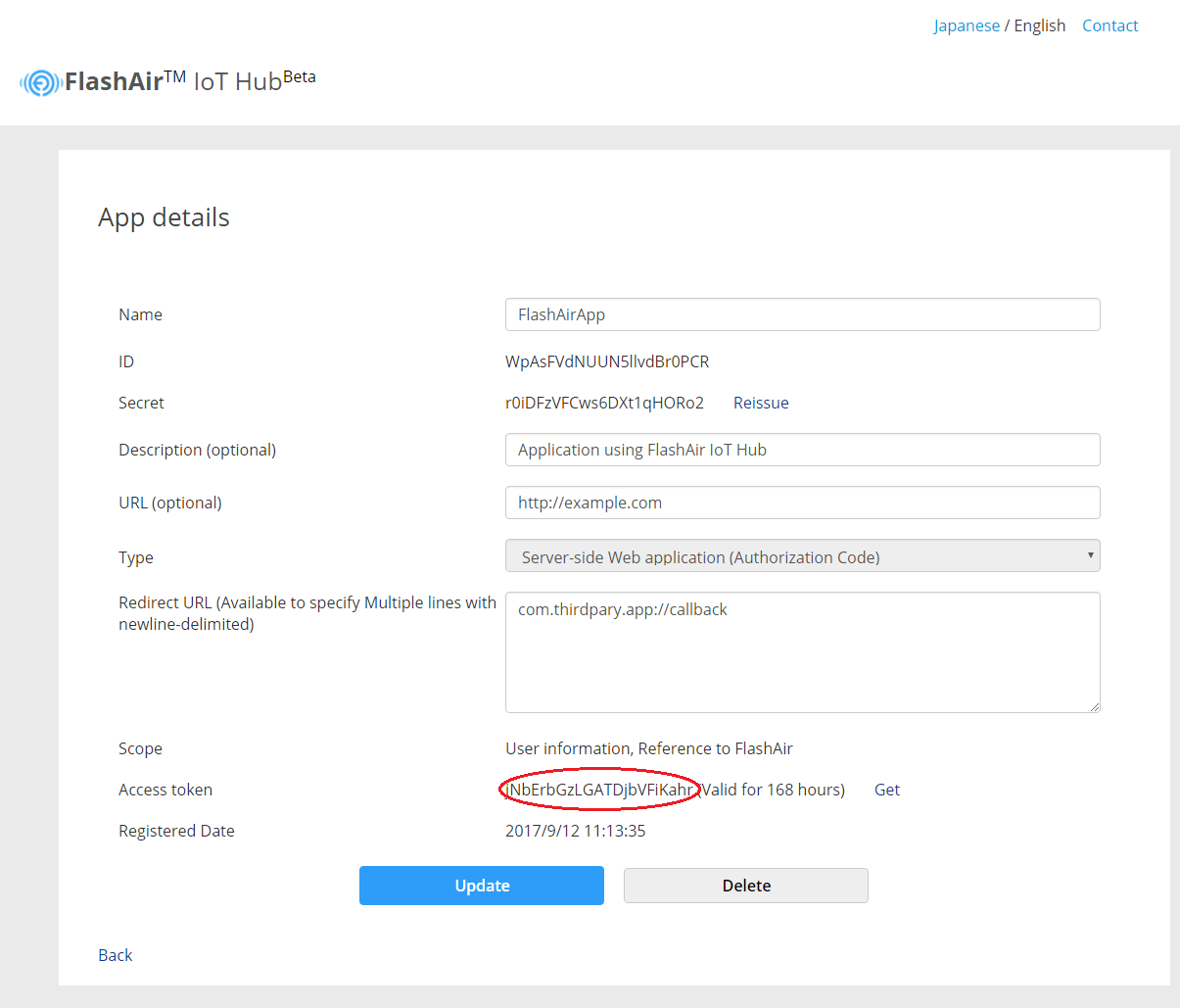
The following tutorial introduces samples that actually use the FlashAir IoT Hub API.
 FlashAir™ Developers
FlashAir™ Developers